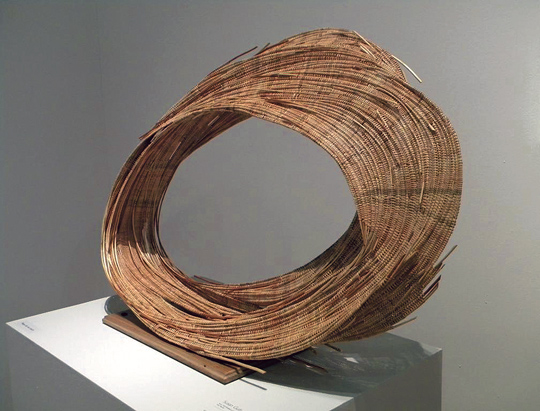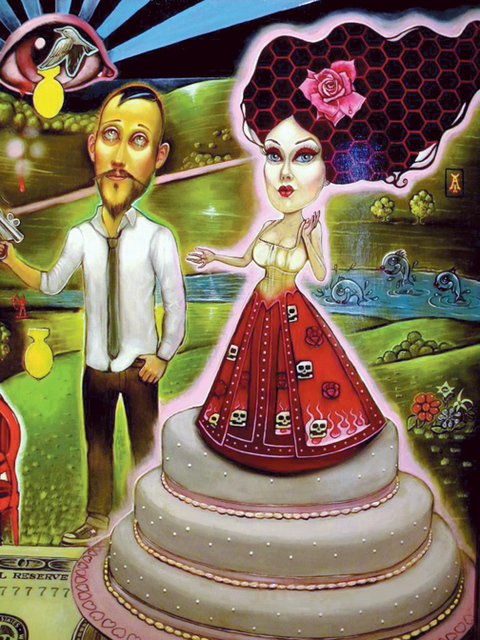It’s Sunday, the opening of Albuquerque Now: Winter, and the Albuquerque Museum of Art and History is alive. A tiny girl in black-and-white stripes reaches for John G. Garrett’s “Now Net,” a suspended Technicolor waterfall of aluminum wire, plastic cable and recycled picnic ware, among other found elements. Her mother, in turn, reaches for her, saying, “No, love. Touch with your eyes.” A dapper young man exclaims to his girlfriend, “Can you [adverb beginning with ‘f’] believe that all of these artists are from Albuquerque!” And an older woman, relying on her cane for support, sweetly greets her friend with, “We so need art to get us through these times . ”The crowd shares a noticeable awe for the 100 works of art that comprise Albuquerque Now: Winter . The awe is deserved, for the concept, creativity and craftsmanship of each individual piece is exceptional. And when you pause to consider the scope of the show, that all of the works—representing a staggering array of media—demonstrate that same visionary quality, and that 60 other equally vibrant artists participated in the first installation this fall, chills run up your spine so quickly that you (and the dapper young man) can do little to contain your explicit exclamations.Even if you know this before you set foot in the museum, at some point during your exploration of the show, you really understand that all 101 artists (one of the 100 works is a collaborative piece) are Albuquerqueans. Some are of New Mexican origin, like Damian Velásquez, whose cubist “Chair and Side Table” in power-coated expanded metal might just make the fathers of Bauhaus blush with esteem. Others were drawn here from far away, like Cuban-born Cecilia Portal, whose black-and-white large-scale pigment prints, “Carne y Hueso #1 & #2 (Flesh and Bone #1 & #2),” bring Man Ray to mind, catching the eye from far across the cavernous room.Whatever the artists’ origins, they’ve all chosen Albuquerque. The artist-led gallery talks, which play a starring role in the show’s commencement, are kind of like a neighborhood garden tour. Except we don’t learn why so-and-so chose tiger tulips for the front path (let it be known: I believe gardening is an art form). Instead, Antonio Roybal reveals why he uses egg tempera and oil in his paintings: Because the combination achieves a vibrancy of color that channels the Northern Renaissance painters—whom Roybal, a self-proclaimed art history buff, greatly reveres. And you can learn that his work “One World,” which he calls a “modern family portrait,” features fantastical imagery and accentuated caricatures because they portray “symbols that speak to the American consciousness right now.” Though it’s not entirely clear why a bumblebee with a clown nose is emblematic of our national psyche, Roybal’s discussion of his artistic process is fascinating.On this day, our neighborhood artists continue the tour until six have revealed the ways of their works. John G. Garrett demonstrates the magnificent system that built “Now Net”—a meticulous repetition of steps, one shimmering six-foot strand of wire and found objects following another, then another and another, until a curtain of color took shape. We cross the gallery to Susan Gutt’s “The Wave,” an oblong “O” meticulously woven of bamboo, cane and two types of willow. And then again to Anne Cole’s “Cupid,” a working viola named for the red hue of the wood’s stain and identifiable by the god of love painted inside. L. Eugene Nelson tells the story of his “Bolo-Extraordinaire,” a fantastic piece of silver, gold and precious stones that took years to conceive and then weeks to execute. But before he does, Jennifer Vasher narrates “Entitlement; The Past Is Never Dead and Buried,” an all-white room centered around a fainting couch and composed of what look like a million Aspirin and Tylenol pills strung together on draping threads. Vasher spent two years on the piece, which may sound like a lot of time, but when you see the painstakingly intricate structure, you wonder how 24 months was possibly enough.Apart from the tour’s presenters, a number of Albuquerque Now artists wander through the gallery. A vivacious gentleman and I admire Louis Schalk’s “The Museum of Reaccession.” Conceptually the most interesting piece in the show, it’s an antique set of drawers outfitted with artifacts on loan from smaller museums in New Mexico. It’s not until the fourth drawer down that we make a proper introduction, and I learn that this gentleman is Vasili Katakis—the creator of “Persephone,” a stunningly skillful pastel hanging just around the corner from where we stand. And as I contemplate Barbara Grothus’ “Cultural Palynology,” she appears beside me and explains that the work examines the “destruction of antiquity,” “internal contemplation versus war and empire” and the “palyns of 33° latitude.”My Sunday lesson on Albuquerque arts may have been shaped in part by coincidence, but it surely didn’t happen by accident. Because Andrew Connors, the museum’s curator of art and the mind behind Albuquerque Now , is a champion of community. As he explains, the aim of the two-part installation and its related events is to “revel in what’s going on in our neighborhood.” Though the shows’ grasp cannot possibly reach every artist in a city is so rich with talent, I believe that Connors formed a broadly representative collection of works—a collection we should extol not only for what it contains, but for the incredibly diverse and accomplished community it epitomizes.
Albuquerque Now: Winter Runs through April 18 Albuquerque Museum of Art and History2000 Mountain NWcabq.gov/museum, 243-7255











